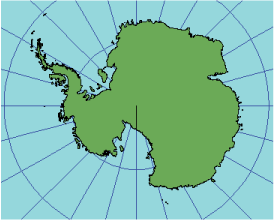Description
The projection is equivalent to the polar aspect of the stereographic projection on a spheroid. The central point is either the North Pole or the South Pole. This is the only polar aspect planar projection that is conformal. The polar stereographic projection is used for all regions not included in the UTM coordinate system, regions north of 84° N and south of 80° S. Use UPS for these regions.
Learn more about the stereographic projection

Projection method
Planar perspective projection, where one pole is viewed from the other pole. Lines of latitude are concentric circles. The distance between circles increases with distance from the central pole.
Point of tangency
A single point, either the North Pole or the South Pole. If the plane is secant instead of tangent, the point of global contact is a line of latitude.
Linear graticules
All meridians.
Properties
Shape
Conformal; accurate representation of local shapes.
Area
The farther from the pole, the greater the area scale.
Direction
True direction from the pole. Local angles are true everywhere.
Distance
The scale increases with distance from the center. If a standard parallel is chosen rather than one of the poles, this latitude represents the true scale, and the scale nearer the pole is reduced.
Limitations
Normally not extended more than 90° from the central pole because of increased scale and area distortion.
Uses and applications
Polar regions (conformal).
In the UPS system, the scale factor at the pole is 0.994, which corresponds to a latitude of true scale (standard parallel) at 81°06'52.3" N or S.
Parameters
Desktop
Stereographic_North_Pole
- False Easting
- False Northing
- Central Meridian
- Standard Parallel 1
Stereographic_South_Pole
- False Easting
- False Northing
- Central Meridian
- Standard Parallel 1
Workstation
- Longitude of Central Meridian
- Latitude of true scale
- False Easting (meters)
- False Northing (meters)